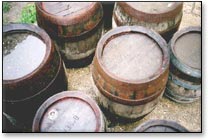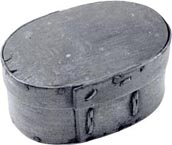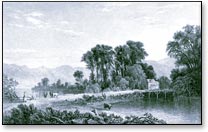As the traffic in butter increased, larger containers came into more general use and became popular as they permitted shipment of their contained butter to more distant markets. Dairies became neighborhood affairs where one farmer did the churning for a few of his more immediate neighbors. In the last half of the 19th Century, small shipments developed into traffic whereby the bulk of the stock to reach New York City, for example, came by river boats. Many of the dairies in these areas developed a craftsmanship and quality of product that had an appreciable trace acceptance even in the early 1900's.
Many of these dairies made a good deal of butter during the summer and early Fall, packing the summer product (or "June" butter as it was commonly called) in casks or "firkins" holding an English hundredweight of 112 pounds. Some grocers for the home retail trade liked it. In packing these firkins, it was common practice to bore a small hole in the head, just before shipping, and pour in as much clear, well skimmed brine as was required to fill any vacancies between the butter and the package, thus displacing the air, and closing the hole with a well fitting peg cut off flush with the surface.
The firkin owed its popularity as a bulk butter container because it permitted the storage of butter without quality impairment and without refrigeration. It kept butter in good condition in the springhouse on the farm, in a commission-house cellar in New York or Chicago or in the hold of a ship rounding Cape Horn enroute to the Orient. To consider some of the problems confronting the makers of dairy butter in the 19th Century, here is a letter addressed to the Editor of the Chicago Dairy Produce in 1899 concerning the experiences of one D. Hall in the days of dairy butter:
"Having been born in New York in the year 1844 upon a farm on the Chenango River and in the county of the same name, I have seen the growth of the dairy business of that state. My first experience was with sheep and cows, as most farmers kept both. We used the old-fashioned 10-quart pan, straining the milk in these and letting it set in a milk room to rise, using a tin skimmer when the cream was ready to skim. We kept our cream from two to three days, stirring it as often as we came into the room and also when we put in fresh cream. We used a dash churn for a number of years, and then purchased a crank churn with a dash inside, which turned and thereby agitated the cream. We always stopped churning as soon as the butter had gathered enough to draw off the buttermilk. The butter was washed in the churn, and then removed to a large wooden bowl in which it was mixed with the salt, but not worked too much to injure the grain. The butter was set away in the cellar until the next day, when we re-worked it in the same bowl, using a ladle (there were no workers in those days) until we had it the desired shade, which every dairyman knows but can hardly describe. The butter was now packed into 100-pound firkins and it usually took two or three churnings to fill each. Then a cloth wet with brine made of saltpeter was placed over the top and the space filled with wet salt. (Now, boys, don't kick because we used an `embalming fluid' over our butter, as I think if some of us would use the same plan nowadays there would be less butter with strong tops.) These firkins were kept in the cellar from about the 20th of May until late in the Fall, or until it got cold enough so buyers could ship to New York City, as this was our only market. And how do you think we shipped? Why, by the `raging canal' -- the old Chenango canal to Utica, then the Erie canal to Albany, then down the Hudson River to New York City. No railroads in those days."



